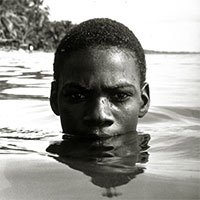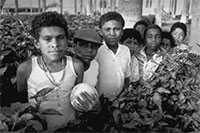Culture through the Camera
Photographer Tony Gleaton left the world of glamour magazines for a lifetime commitment of photographing people of different cultures
By CHHUN SUN
Call photography professor Tony Gleaton at his Texas Tech University office and you will hear the following: “Hi, this is Tony Gleaton. I’m more than likely out of the office; I’m on location this summer, so please leave a message, OK? And I’ll get back to you within a day or so.”

Clockwise from top: No name provided; Abrazo De La Memoria/”Embrace of Memory,” taken in Cuajinicuilapa, Guerrero, Mexico, 1990; Un Hijo De Yemayha/”A Child of Yemaya,” taken in Hopkins, Belize, 1992. Photos courtesy of Tony Gleaton |
A day later, you call and reach the same voicemail.
Don’t be surprised, though; this is Tony Gleaton, a photographer who has traveled more than 50,000 miles through the dusty roads of Mexico, stayed in the small villages of Central and South America and hitchhiked his way through the American West.
So don’t worry; he’ll get back to you — within a day or so, right? Right.
He calls you on the third day shortly after 10 p.m.
“I’m in L.A.,” he says.
He’s on the road — not surprisingly — giving lectures at California universities.
This Tuesday, he will give a lecture at Fresno State as part of the University Lecture Series. He will talk about his personal vision and experience in “Africa’s Legacy in Mexico, Central and South America” at 7:30 p.m. in the Satellite Student Union.
He visited Fresno 12 years ago when Fresno City College displayed his work. Since then, he has visited and photographed the people of Central and South America.
“I’ll be talking about that entire body of work,” Gleaton said of his visit to Fresno State. “I will talk about how to manifest a personal vision and what you have to go through to do projects I do.”
But on this Thursday night, Gleaton sounds tired. He’s doing several tasks at once: talking on the phone, talking to his cab driver, running errands at Kinko’s. But when he gets his errands done, he can go to his hotel room and enjoy a good night’s rest.
But there’s a lifetime of work to talk about before he visits Fresno State.
His aptitude in photography started in the 1970s when he attended UCLA. After graduation, in 1977, he left for New York, photographing for fashion magazines. His stint didn’t last long — only about three years.
“After that, I just got tired of that kind of work,” Gleaton said. “It’s very difficult to do this kind of work in the United States, because everybody wants to get dressed up and put makeup on and that really distracts from the photos, especially when I’m looking for something else. I’m in search of the things you cannot see; it’s the things you can feel.”
This is where his journey of photographing real people in black and white began.
This is when he started his hitchhiking around America. This time period eventually formed the core of his project “COWBOYS: Reconstructing an American Myth,” a series of photos of African, Native-American, European, Mexican and Mexican-American cowboys.
 Then he joined the people who lived in the mountains of Mexico and the sands of the Grand Canyon. Then he joined the people who lived in the mountains of Mexico and the sands of the Grand Canyon.
These visits formed his most celebrated project, “Africa’s Legacy in Mexico,” photographs of the descendants of African slaves brought to New Spain in the 1500s, 1600s and 1700s.
Before he actually photographs these people, Gleaton immerses himself in their culture and lifestyle for months — sometimes years.
“I don’t take many photos at all,” Gleaton said. “In a year, I take about 60 rolls of film, and that’s not a lot.”
There’s a reason why, he said.
“I take photos and I use them to address larger issues. It’s not so much about the picture but where the pictures derive from. I’m interested in how images look, I’m interested in crafting a beautiful image, but I’m also equally interested in engaging a conversation about a topic I want to explore.”
Yes, that’s exactly the kind of photographer he is.
He embraces and explores keenly the land and people he visits. That’s why he would rather use ground transportation, if possible, when he’s visiting, say, South America or the South Pacific. This is his unique way of seeing images through the lens. Not only do you see the subject, but you also see its influence.
“It’s kind of tricky, because yes, in a way, I do images based on social situations where people live,” Gleaton said, “but what happens most of the time, the images I produce are highly manipulated. The images tell as much about me as about the people I’m photographing.”
That’s what he likes to do — photograph real people in real situations with his touch.
For a man who has spent almost 40 years photographing people, he still has some trouble explaining what he really does.
Is it just simply photographing people? Is it anthropological photography, in which he documents people’s everyday habits? Or is it more than that?
 Well, yes, it’s a love. Well, yes, it’s a love.
“It’s like if you’re in love with somebody,” he said. “They can be really beautiful or not so beautiful, but the issue is how they make you feel and how you feel toward them. That’s what I’m engaging.”
But Gleaton said he can’t do projects and travel the way he once did.
“I used to love it, but I’m getting too old now,” he said. “Because the [stuff] beats me to death. It’s one thing if you’re 23 or 35, but I’m older than your parents — I’m 56. This is the [stuff] I can’t do now. I used to do it without thinking.”
Those are words from a man who has seen life at its worst and best, his travel mileage adding up. But he still has projects in the works, including “The Book of Cowboys” and photographing landscapes that represent historical tragedies — for example, lynchings in the South.
“But you just keep working at it until you get what you need,”
Gleaton said. “You can’t accept that you’re tired or
running out of money or you’ve got something else you wanna do;
it doesn’t make any difference.”
So you know...
What: Africa's Legacy in Mexico, Central and South America
Where: Satellite Student Union
When: Tuesday at 7:30 p.m.
Cost: $12 general; $8 faculty/staff/alumni association,
seniors and high school students; $2 Fresno State and UHS students
Contact: www.csufresno.edu/universitylecture
|
